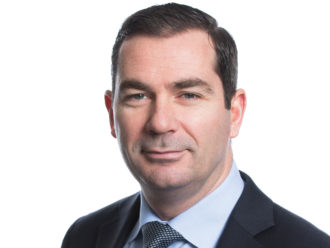Could you give me an insight into your responsible investments?
It is not about investments that are responsible; it is a whole process that is always being a responsible investor. So our responsible investments are our entire portfolio – it is about the process we go through as an asset manager that makes us a responsible investor.
The portfolio is diversified globally.
Asset-class wise, there will be examples that people would expect to see from a responsible investor: wind farms and all the good stuff on the green side of the spectrum.
But you need all sorts of investments in a portfolio to get the returns needed for our client funds to pay their pension beneficiaries.
So it is about identifying sustainable investments, which come in all sorts of complexions, colours and types across the whole portfolio
So you don’t have your portfolio and then a bucket of responsible investments – the responsible investment approach runs throughout your portfolio?
Yes, it’s a constant. Think of a stick of rock, which is what we are, rather than a packet of sweets.
Therefore how would you describe your philosophy underpinning your responsible investment approach?
It goes back a long way. Probably before LPPI was born, in terms of the conviction of the investors that brought the partnership together.
But in terms of the philosophy now, it is very much focused on what we are here to do as an organisation: it is our corporate purpose, that delivery of sustainable return over the long term. That means responsible investment has to be integrated into everything we do.
Could you explain your quite ambitious plan to achieve net zero by 2050?
Net zero is the logical step forward. This is about the long-term sustainability of the market and being a responsible investor. You want to see the whole market rise and we are investing in the whole of the market.
It is around wanting to see that progress towards the Paris Agreement’s targets, to be decarbonising all sectors and all companies to be decarbonising.
So looking for your sources of sustainable return from as big a landscape as you can. You cannot do that by picking and choosing. You need to work across the whole market.
The net-zero commitment is ambitious in terms of the work that needs to be done. But we are quite clear that is in partnership with everyone in the market: government, policy setters and regulators. It is the whole market’s responsibility to get to net zero.
We are an asset manager on behalf of public sector pensions, and our job is to get them a long-term sustainable return. Arguably, you won’t be able to do that if you don’t have a net-zero aligned portfolio going forward.
Is it a challenge to keep an eye on the here and now, getting your returns and then having a 2050 net-zero objective?
If you think about the framing of the net-zero commitment, it is not about greening the portfolio; it is about transitioning the portfolio.
The most successful transition portfolio will be where you don’t need to change anything because the companies you are investing in are changing as you own them.
As long as you keep clarity on what you are here to do, over time more of the market is going to be in that place, but you need to be tracking what you are doing. You need to be setting targets, ambitions and expectations in the market and review that they are meeting them or not. You want the companies you are holding to be the ones which are transitioning.
What are the biggest challenges in addressing responsible investment and net zero from an asset-owner perspective?
There can be practical challenges. For example, how do you evaluate how aligned a company is with net zero? ESG is easier the closer you are to an individual company or asset. The minute you move away from being that detailed, the more complexity you build in. And a net-zero portfolio is complex.
On an individual decision-making level the challenge is data. It is having the information and insight to understand where individual company mandates are and their capacity, and commitment, in moving to net zero.
The whole market has a contribution to make to ensure it is easier for investors to understand where companies are positioned by the reporting information available.
There is a major imbalance on the availability of information in public markets versus for private companies. A great deal of focus is on public equities, but not so much large data sets in private companies. Where there isn’t disclosure you have to judge on more generic data that you would prefer not to use.
Do you see that the push back in the US around ESG could come to Europe and the UK?
It is not going to be influential like that in Europe and the UK. In ESG, even though the title itself is problematic, there is an understanding of the sustainability of companies and that the market is evaluated by more than just traditional financial information in the UK.
Investors need to be looking at the drivers of sustainability, which are the E and the S characteristics. Companies being well received by the market need to cover these. That is not going to disappear. So there is no opportunity to row back on this, even if people wanted to.
Do you see a positive trajectory on ESG-related issues among the companies in which you invest, or are some proving problematic?
There are shades of strength to shades that are less strong across the portfolio. But companies increasingly understand the investor interest in ESG. Evidence suggests that it is something they are taking on board. After all, it makes good business sense.
They may not sometimes have the language to talk about how they are doing this or lack the budgets if they are not multi-national companies, but in terms of the journey, more companies are on it, and that is what we are looking for. It is not just about the best getting better, but the whole market moving forward.
You are also heavily focused on engagement and stewardship. How do you approach them?
Ultimately, it is the point of good asset selection. Choosing the right assets in the first place is important. Once you hold the assets, it is being active in the ownership of them. You cannot be active on every asset you own; you are relying on regulators, asset managers and other players to hold companies to account. But the aim is always to get the best out of companies.
When companies don’t react in the way you want does divestment become an option?
Divestment is a loaded term. It suggests a cliff-edge outrage. Where actually, the reality is usually more of a continuous process of portfolio managers re-assessing sustainability for everything they hold and consider whether those companies are on the right path.
So you consistently see disinvestment for a variety of reasons, as part of asset management. Divestment can, sometimes, be the right thing to do, but it has to be a full 360 consideration of what is happening, and not just on one issue, in that you are unhappy with one thing. You look at it in the round. It is not done on a whim.
Does the S part of ESG also feature in your responsible investment approach?
It does. There appears an apparent over balance given to the E – with climate change under the E putting everything in the shade – but the reality is that climate change is the E, the S and the G all at the same time. If you sit down and assess what the S is, it is everything.
The challenge with the S is that it has no sharp edges. It hasn’t any natural measures that help box it up in a nice clean way, which you can with climate change.
In our assessment of risk return, the S is most definitely in that mix. Companies who treat their employees appropriately within social norms, fulfilling their responsibilities to society and recognising products that are needed, all of that is the S.
What does the investment industry need to improve upon in addressing responsible investment?
We are not doing a bad job. It comes back to it being incredibly challenging to demonstrate what you are doing. It is easier to articulate an approach and describe a process and harder to get into the outcome with something explicitly, unless you are an impact investor, then that is part of the measurement of the outcome. Our chief investment officer uses a phrase: ‘We are an investor with impact, not an impact investor.’”
Are asset managers up to speed on responsible investment – as some asset owners have accused asset managers of being disconnected with the RI journey?
We are running pooled funds, so there can be the need for compromise, but I wouldn’t say there is misalignment. It is just recognising the logistics of how we invest.
We are very much supported by our clients and listen to what they want.
Has the government done enough to address ESG, or has it dropped the ball on these issues?
Government and policy setters are an important part of the market. The prime minister has different pre-occupations of what UK plc needs to be delivering.
But if the government wants to encourage private capital to invest in climate goals it has to do that by incentivising that capital to where it wants, and needs, it to go.
So the government needs to understand the objectives of investors. The influence comes through the incentivisation or de-incentivisation, which comes through the policy, and particularly the fiscal policy route. And investors need policy certainty.
In the eight years that you have been head of LPPI’s responsible investment team what has been your biggest achievement?
The biggest achievement is where we are now. We have put a real importance on responsible investment. RI is not what the RI team does, but what everyone in the business does, wherever they sit. That is a great place to be.
What has been the biggest lesson of your career?
My biggest lesson is that my contribution is one perspective, and that I do not have all the right answers. It is the recognition that there are a lot of other people with ideas and perspectives that can teach me a lot.





Comments